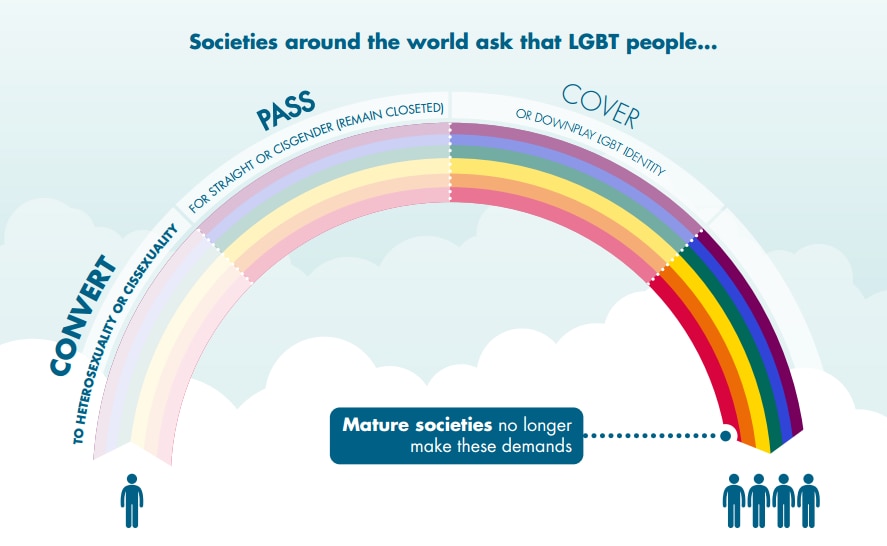Beyond Pride: Building inclusive workplaces with LGBTQIA+ allyship
Did you know that nearly half of LGBTQIA+ workers hide their identity at work due to unwelcoming environments, and are often compelled to change their behavior to avoid drawing attention to their sexual orientation or gender identity?
Despite the progress with Diversity, Equity, Inclusion, and Belonging (DEIB) goals becoming the central boardroom agenda, Gallup’s report––one that measures employee engagement at workplaces–shows that about 45 per cent of LGBTQIA+ employees still face workplace discrimination. This prejudice and exclusion take a psychological toll, often driving them to leave their jobs.

Supporting and empowering LGBTQIA+ employees is crucial. Building LGBTQIA+ allies not only promotes inclusivity in the overall organisational culture, but also supports the well-being of these employees, helping them bring their authentic selves to work without fear.
“When we celebrate unique identities, experiences, and perspectives, associates feel accepted, and are empowered to reach their full potential. Through awareness, advocacy, and allyship, we are focused on helping our LGBTQIA+ associates feel a sense of belonging and creating opportunities for the broader community,” Bhumika Srivastava, people leader, Walmart Global Tech, shares with indianexpress.com.
 Promoting inclusivity is not just a moral imperative, but a strategic advantage that can drive business success. (Source: WEF 2017)
Promoting inclusivity is not just a moral imperative, but a strategic advantage that can drive business success. (Source: WEF 2017)
What is LGBTQIA+ allyship?
Allyship in the workplace refers to the actions and attitudes of individuals who support the LGBTQIA+ community. Allies play a crucial role in challenging discriminatory behaviors, advocating for equitable policies, and fostering a sense of belonging for all employees.
Why LGBTQIA+ allyship matters
Diversity fuels innovation, and belonging drives performance. When everyone feels valued for who they are, they can bring their best selves to work and reach their full potential.
“Growing up in a conservative town, I struggled for years to share my identity as a gay man with loved ones,” says Praveen M, senior analyst at Advanced Technology Centres. “A colleague’s supportive social media post inspired me to come out at work. Their love and acceptance empowered me to live openly. Today, I embrace my true self with pride,” he says.
How to be an LGBTQIA+ ally
BetterUp’s 2021 report––after extensive research on “The value of belonging at work”––highlights that employees who feel a strong sense of belonging are 56 per cent more likely to perform at their highest potential, while companies with higher levels of diversity and inclusion are 35 per cent more likely to outperform their competitors.
“I make a conscious effort to use inclusive language in all my interactions, respecting people’s pronouns and avoiding heteronormative assumptions. I actively participate in diversity education programmes and workshops to increase my own knowledge and understanding of LGBTQ concerns, issues, and experiences, as I believe continuous learning is essential for being an effective ally.” Aditi Khandelwal, a PR professional, shares her insights on being an effective LGBTQIA+ ally at work.
 LGBTQIA+ Ally: Here are a few ways to encourage allyship in the workplace. (Source Adobe Stock)
LGBTQIA+ Ally: Here are a few ways to encourage allyship in the workplace. (Source Adobe Stock)
Building inclusive policies:
Mercer’s 2022 LGBTQIA+ Workplace Inclusion Report found that companies with robust LGBTQIA+ policies see a 23 per cent increase in employee retention. “We take a very intentional approach to attracting, developing, and enabling LGBTQIA+ talent through our inclusive policies, specialised learning programmes, vibrant employee resource groups, and a global network of over 119,000 allies,” shares Lakshmi C, managing director and lead of human resources at Accenture India.
Promoting sensitization through training:
Allies can organise or participate in training sessions, workshops, and discussions to educate themselves and others about LGBTQIA+ issues. According to LinkedIn’s Global Talent Trends report of 2023, companies investing in diversity training see a 32 per cent increase in employee innovation.
Use inclusive language:
Language plays a crucial role in creating an inclusive environment. Use gender-neutral language whenever possible and respect people’s preferred pronouns. Avoid making assumptions about someone’s gender identity or sexual orientation based on their appearance or behaviour. Using inclusive language signals that you recognise and respect diversity.
Lead by example:
Shweta Mohanty, vice president and head of human resources at SAP, India, believes senior leaders should lead by example, showing support for the LGBTQIA+ community openly. “Senior leaders must advocate for inclusive, equitable environments—not just within the company but society as a whole. To put this belief into action, I lead by example and take concrete steps to support LGBTQIA+ employees, giving them a safe space to share their challenges and seek support.”
It’s time to move beyond rainbows and start allying with actions.
The work towards LGBTQIA+ inclusion must remain a steadfast priority, not just during Pride, but throughout the year. The journey ahead is long, but with committed allies, we can progress towards a more just, equitable, and vibrant workplace for all.
Disclaimer: The copyright of this article belongs to the original author. Reposting this article is solely for the purpose of information dissemination and does not constitute any investment advice. If there is any infringement, please contact us immediately. We will make corrections or deletions as necessary. Thank you.
